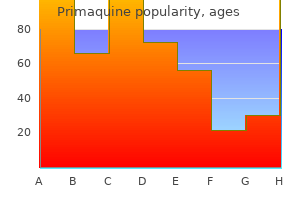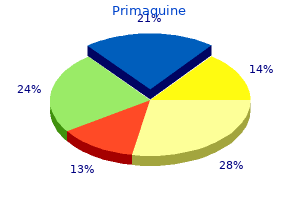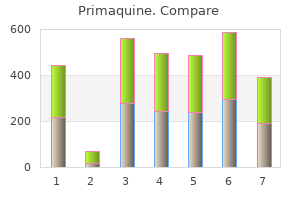Primaquine
"Order cheap primaquine on-line, medicine cabinets recessed".
By: B. Ayitos, M.B. B.CH. B.A.O., Ph.D.
Co-Director, Saint Louis University School of Medicine
He is founding member and officer of the American Association of Medical Chronobiology and Chronotherapeutics administering medications 8th edition buy primaquine 15 mg. He is a member of the American Society of Nephrology symptoms meningitis purchase discount primaquine online, the Southwest Pediatric Nephrology Study Group medicine articles order primaquine 15 mg online, the American Society of Pediatric Nephrology treatment 5th metatarsal stress fracture primaquine 7.5mg online, and the International Pediatric Nephrology Association. He has reviewed dozens of abstracts and manuscripts for many nephrology and physiology journals and is on the editorial boards of Seminars in Nephrology and the American Journal of Physiology and Renal Physiology. Dr Schwartz has printed over 170 papers, including articles, books, abstracts, and letters in nephrology. He is a member of the American Society for Clinical Investigation, American Society of Pediatric Nephrology, the International Pediatric Nephrology Association, the Society for Pediatric Research, and the American Society of Nephrology. James Smith, Nadine Ferguson, Donna Fingerhut, and Kerry Willis, PhD, had been instrumental in coordinating the project. Stefan Armstrong, marketing consultant editor, offered invaluable help in making ready the report. The Work Group is indebted to the Evidence Review Team, who worked tirelessly to assemble the proof and creatively to synthesize the data. The Work Group appreciates the cautious evaluate of the draft pointers and suggestions for enchancment by external reviewers. Each remark was fastidiously considered and, each time attainable, suggestions for change had been incorporated into the ultimate report. The National Kidney Foundation, as well as the Work Group, acknowledge the help of Amgen. The National Kidney Foundation is proud to associate with Amgen on this essential initiative. As Chair of the Work Group, I personally wish to thank the opposite members of the Work Group who volunteered their time, effort, knowledge, and humor to this project. Their willingness to take into consideration the ``big picture' whereas steadfastly adhering to accuracy about ``small particulars' is liable for the breadth and depth of these pointers. Iseki K, Iseki C, Ikemiya Y, Fukiyama K: Risk of developing end-stage renal illness in a cohort of mass screening. Dahlquist G, Rudberg S: the prevalence of microalbuminuria in diabetic children and adolescents and its relation to puberty. Chiumello G, Bognetti E, Meschi F, Carra M, Balzano E: Early diagnosis of subclinical issues in insulin dependent diabetic children and adolescents. Laborde K, Levy-Marchal C, Kindermans C, Dechaux M, Czernichow P, Sachs C: Glomerular perform and microalbuminuria in children with insulin-dependent diabetes. Murakami M, Yamamoto H, Ueda Y, Murakami K, Yamauchi K: Urinary screening of elementary and junior excessive-college children over a 13-yr period in Tokyo. A six-yr research of regular infants, preschool, and schoolage populations beforehand screened for urinary tract illness. Guidance for Industry Pharmacokinetics in Patients with Impaired Renal Function: Study Design, Data Analysis and Impact on Dosing and Labeling. Dusing R, Weisser B, Mengden T, Vetter H: Changes in antihypertensive remedy: the position of antagonistic results and compliance. Matching the Intensity of Risk Factor Management with the Hazard for Coronary Disease Events. Profiles of General Demographic Characteristics: 2000 Census of Population and Housing, United States. Agarwal R, Nicar M: A comparative analysis of formulation used to predict creatinine clearance. Sanaka M, Takano K, Shimakura K, Koike Y, Mineshita S: Serum albumin for estimating creatinine clearance within the elderly with muscle atrophy. Tougaard L, Brochner-Mortensen J: An particular person nomogram for determination of glomerular filtration fee from plasma creatinine. Yukawa E, Hamachi Y, Higuchi S, Aoyama T: Predictive performance of equations to estimate creatinine clearance from serum creatinine in Japanese sufferers with congestive coronary heart failure. Collaborative Study Group of Angiotensin Converting Enzyme Inhibition in Diabetic Nephropathy.
Artemisiae vulgaris radix (Mugwort). Primaquine.
- How does Mugwort work?
- What is Mugwort?
- Stomach problems (colic, diarrhea, cramps, constipation, slow digestion, vomiting), epilepsy, irregular menstrual periods, low energy, anxiety, itching caused by scars, and other conditions.
- Are there safety concerns?
- Dosing considerations for Mugwort.
Source: http://www.rxlist.com/script/main/art.asp?articlekey=96163

The frequency of opposed experiences was not related to complete daily dosage throughout the ordinary dosage ranges treatment spinal stenosis quality primaquine 7.5 mg. The incidences represent the experiences from each managed and uncontrolled clinical trials (most duration of therapy was roughly one year) symptoms 2dp5dt buy discount primaquine. In the placebo treated patients 300 medications for nclex generic 15mg primaquine with visa, the incidences reported are from the managed trials (most duration of therapy is 12 weeks) medicine world discount primaquine 7.5 mg without prescription. Hematologic: Rare circumstances of neutropenia, thrombocytopenia and bone marrow depression. Nervous/Psychiatric: Depression, confusion, ataxia, somnolence, insomnia, nervousness, peripheral neuropathy (e. Respiratory: Bronchospasm, rhinorrhea, sore throat and hoarseness, bronchial asthma, upper respiratory an infection, pulmonary infiltrates, eosinophilic pneumonitis. Skin: Exfoliative dermatitis, toxic epidermal necrolysis, Stevens-Johnson syndrome, pemphigus, herpes zoster, erythema multiforme, urticaria, pruritus, alopecia, flushing, diaphoresis, photosensitivity. Special Senses: Blurred vision, taste alteration, anosmia, tinnitus, conjunctivitis, dry eyes, tearing. Pediatric Patients the opposed expertise profile for pediatric patients appears to be much like that seen in grownup patients. Creatinine, Blood Urea Nitrogen: In managed clinical trials minor will increase in blood urea nitrogen and serum creatinine, reversible upon discontinuation of therapy, had been observed in about 0. Increases in blood urea nitrogen or creatinine had been a trigger for discontinuation in 1. Hematology: Small decreases in hemoglobin and hematocrit (imply decreases of approximately 0. Single oral doses of enalapril above 1,000 mg/kg and 1,775 mg/kg had been associated with lethality in mice and rats, respectively. The most likely manifestation of overdosage could be hypotension, for which the usual therapy could be intravenous infusion of regular saline solution. The ordinary dosage vary is 10 to forty mg per day administered in a single dose or two divided doses. In some patients treated as soon as daily, the antihypertensive effect could diminish toward the tip of the dosing interval. In such patients, an increase in dosage or twice daily administration should be thought-about. Dosage Adjustment in Hypertensive Patients with Renal Impairment the usual dose of enalapril is beneficial for patients with a creatinine clearance >30 mL/min (serum creatinine of as much as roughly 3 mg/dL). For patients with creatinine clearance 30 mL/min (serum creatinine 3 mg/dL), the first dose is 2. In the placebo-managed studies that demonstrated improved survival, patients had been titrated as tolerated as much as forty mg, administered in two divided doses. Doses should be titrated upward, as tolerated, over a interval of a few days or weeks. The most daily dose administered in clinical trials was forty mg in divided doses. If possible, the dose of any concomitant diuretic should be decreased which can diminish the likelihood of hypotension. Asymptomatic Left Ventricular Dysfunction In the trial that demonstrated efficacy, patients had been began on 2. Following the 60 minute maintain time, shake the concentrate for a further minute. The suspension should be refrigerated at 2-eight�C (36-forty six�F) and may be stored for as much as 30 days. Existing follow pointers might be reviewed for revision or renewal, as acceptable, on their fifth anniversary or sooner, if indicated. Donald Blaufox, Co-Chairman Diego De Palma committee: Yi Li, Alain Prigent, Martin Samal, Andrea Santos, Zsolt Szabo, Andrew Taylor, Giorgio Testanera, Mark Tulchinsky I.

Oestrogens are generally believed to be the main factor responsible for the blood strain elevating impact medications 7 rights cheap 15 mg primaquine with mastercard, but the mechanisms are as yet unknown [640] treatment 0f gout generic primaquine 15 mg visa. Although oestrogens have been reported to improve endothelial operate [641] symptoms before period buy primaquine 7.5 mg without prescription, their administration can also stimulate the hepatic synthesis of angiotensinogen [642] medicine 4 times a day primaquine 15 mg otc. Furthermore, arterial distensibility fluctuates during the menstrual cycle in relation to changes in oestrogen concentration [643], and the use of oral contraceptives has been reported to be associated with an elevated albuminuria [644]. Preparations with an oestrogen content of 30 mg and progestogen of 1 mg or less are regarded to be relatively protected. However, a cross-sectional survey of a stratified random pattern of English women showed that, even though most mixed oral contraceptives used in England in 1994 contained low-dose oestrogen, there have been barely but significantly greater blood strain values (2. In a large potential cohort study in American nurses, a doubling in the adjusted relative danger for hypertension was documented in current users of low-dose oral contraceptives [638]. Several case-control research carried out in the late Nineteen Sixties supported an affiliation between use of oral contracep- In Western societies, women present a steeper enhance in systolic blood strain after the menopause, but whether or not this is due to the impact of age or the menopause is debated as a result of research which have explored this issue have obtained diverging results, i. The most up-to-date cross-sectional study in 18,326 women [652] indicates that the menopause has some blood strain increasing results, but this is small (about three/three mmHg) and largely masked by the pressor impact of aging. This has introduced in regards to the curiosity in investigating the cardiovascular impression of hormone alternative therapy. A number of observational research showed that ladies taking hormone alternative therapy had better cardiovascular danger profiles [659] and a reduced prevalence of coronary illness [660] and stroke [661,662] in comparison with those not taking hormone alternative therapy. Furthermore, a smaller enhance in systolic blood strain over time was reported in postmenopausal women taking hormone alternative therapy in comparison with controls [663]. However, quite than confirming cardiovascular profit, latest massive intervention trials have shown an elevated danger of cancer and cardiovascular disease with hormone alternative therapy [664,665]. A latest Cochrane systematic evaluation indicates that the only important benefits of this therapy was a decreased incidence 2007 Guidelines for Management of Hypertension 1153 of bone fractures and colon cancer, accompanied, nevertheless, by a significantly elevated danger of coronary occasions, stroke, thromboembolism, breast cancer, gallbladder illness and, in women over 65 years of age, dementia [666]. Blood strain usually falls in the second trimester, reaching values that are roughly 15 mmHg lower than before pregnancy. The above fluctuations happen in normotensive women as well as in those who were previously hypertensive or develop pregnancy-particular hypertension. However, while in the past the definition was based mostly on an elevation in blood strain during the second trimester from a baseline studying in the first trimester or before pregnancy, a definition based mostly on absolute blood strain values (systolic blood strain! The prognosis of hypertension in pregnancy must be based mostly on a minimum of two high blood pressure readings on two separate occasions. However, 24 hour blood strain values have been shown to be superior to standard measurements in predicting proteinuria, danger of pre-term delivery, toddler weight at birth and in general consequence of pregnancy [670�672]. For both diagnostic and treatment purposes it could thus be useful to carry out ambulatory blood strain monitoring, significantly in excessive-danger pregnant women with hypertension, or those with diabetic or renal damage. Hypertension in pregnancy contains: Pre-present hypertension, which complicates 1�5% of pregnancies and is defined as blood strain! Gestational hypertension, which is pregnancy-induced hypertension without proteinuria. Gestational hypertension associated with important proteinuria (> 300 mg/l or > 500 mg/24-h or dipstick 2� or more) is named pre-eclampsia. Hypertension develops after 20 weeks of gestation and, in most cases, it resolves inside 42 days submit partum. Pre-present hypertension plus superimposed gestational hypertension with proteinuria. Pre-present hypertension is associated with further worsening of blood strain and a protein excretion rate! It corresponds to the earlier definition of ``continual hypertension with superimposed pre-eclampsia'. Hypertension with or without systemic manifestations based mostly on blood strain measurements after 20 weeks of gestation with no confirmation of earlier values. Under these circumstances re-assessment is important at or after 42 days submit partum.

Acute renal failure associated with diclofenac therapy in an aged girl [letter] medications nurses cheap primaquine uk. Diclofenac sodium: a reappraisal of its pharmacodynamic and pharmacokinetic properties treatment plan goals generic primaquine 15 mg overnight delivery, and therapeutic efficacy treatment effect best purchase primaquine. Proximal tubular dysfunction associated with tenofovir and didanosine causing Fanconi syndrome and diabetes insipidus: a report of three instances medicine q10 discount primaquine 7.5mg online. The effect of meals administration on the bioavailability of didanosine from a chewable pill formulation. Pharmacokinetics of didanosine in patients with acquired immunodeficiency syndrome or acquired immunodeficiency syndrome-associated complicated. Fatal lactic acidosis and acute renal failure after addition of tenofovir to an antiviral routine containing didanosine. Didanosine administration in a human immunodeficiency virus-positive renal transplant patient. Didanosine pharmacokinetics in patients with normal and impaired renal operate: influence of hemodialysis. Effects of digoxin on morbidity and mortality in diastolic heart failure: the Ancillary Digitalis Investigation Group trial. Digoxin and reduction of heart failure hospitalization in persistent systolic and diastolic heart failure. Withdrawal of digoxin from patients with persistent heart failure handled with angiotensin-changing-enzyme inhibitors. Reinstitution of digoxin after digoxin fab antibody therapy in a hemodialyzed patient. Quantitation of interference in digoxin immunoassay in renal, hepatic, and diabetic illness. On the therapy of migraine: pharmacokinetic-pharmacodynamic relationships for programmed launch formulation of dihydroergotamine administered orally in the human. Dihydroergotamine: discrepancy between arterial, arteriolar and pharmacokinetic data. Relationship between the venoconstrictor activity of dihydroergotamine and its pharmacokinetics during acute and persistent dosing. Pharmacokinetics of dihydroergotamine in healthy volunteers and in neurological patients after a single intravenous injection. Low bioavailability as a reason for obvious failure of dihydroergotamine in orthostatic hypotension. Pharmacology of dihydroergotamine and evidence for efficacy and safety in migraine. Pharmacokinetics of dihydroergotamine following subcutaneous administration in humans. Plasma concentrations and protein binding of disopyramide and mono-n-dealkyldisopyramide during persistent oral disopyramide therapy. Disposition kinetics and urinary disopyramide in human healthy volunteers described by an open three compartment model. Does alpha1-acid glycoprotein cut back the unbound metabolic clearance of disopyramide in patients with renal impairment? Disopyramide kinetics in renal impairment: determinants of interindividual variability. Enantioselective regular-state kinetics of unbound disopyramide and its dealkylated metabolite in man. Protein binding of disopyramide and elevated alpha1-glycoprotein concentrations in serum obtained from dialysis patients and renal transplant recipients. Inhibitory effect of free acids on plasma protein binding of disopyramide in haemodialysis patients. The pharmacokinetics of disopyramide in patients with acute myocardial infarction. Stereoselective metabolism and pharmacokinetics of disopyramide enantiomers in humans. Quantitative and qualitative binding characteristics of disopyramide in serum from patients with decreased renal and hepatic operate. Effects of serum concentrations of disopyramide and its metabolite monon-dealkyldisopyramide on the anticholinergic side effects associated with disopyramide.
Primaquine 15mg mastercard. Acute Cholecystitis - Overview (signs and symptoms pathophysiology treatment).

